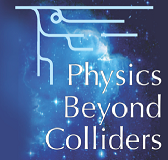Speaker
Description
Sensitive measurements on the short range interactions between macroscopic bodies provide a window on possible physics beyond the standard model, including extra-dimensions, scalar dark matter and dilatons. The sub-micron scale distances is presently not accessible to experimental investigation, and may hold the key to understanding at least part of the dark matter puzzle.
The a-KWISP (advanced-KWISP) proposal builds on the results obtained with the KWISP opto-mechanical force sensor, designed and constructed at INFN Trieste, and enters the short-distance interaction field with the novel “double-membrane” concept. Here interaction distances can be as short as 10 nm, much below the ≈10-30 micron distance which is the lower limit encountered by current experimental efforts. a-KWISP reaches the ultimate quantum-limited sensitivity by exploiting an array of technologies, and by achieving sub-Kelvin membrane temperatures with a combination of cryogenic and optical cooling.
Access to CERN infrastructure will be key to the success of aKWISP, in order to build upon the experience being matured with KWISP at CERN, and to have direct access to advanced technologies readily available at CERN, such as patterned thin-layer coatings and cryogenic cooling.
